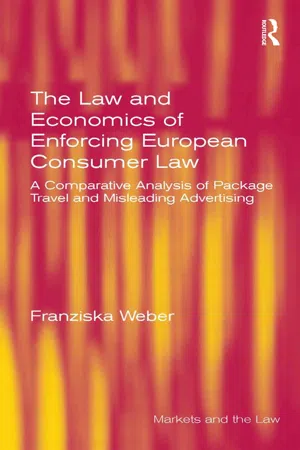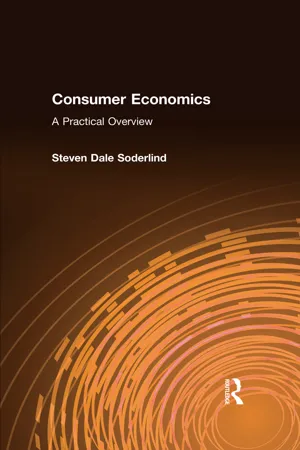Economics
Consumer Protection
Consumer protection refers to the laws and regulations designed to safeguard consumers from unfair or deceptive business practices. It aims to ensure that consumers have access to accurate information, fair treatment, and recourse in case of product or service issues. Consumer protection measures often include product safety standards, truth in advertising requirements, and mechanisms for resolving consumer complaints.
Written by Perlego with AI-assistance
Related key terms
5 Key excerpts on "Consumer Protection"
- eBook - ePub
- Geraint Howells, Stephen Weatherill(Authors)
- 2017(Publication Date)
- Routledge(Publisher)
It covers law which sustains, promotes, curtails and adjusts the structure of a free market. In many cases it is based on political perceptions of the nature of the market economy. Within an overall political acceptance of the desirability of a market economy, there are many nuances of approach towards the way that market should be permitted to operate, with law used to achieve such adjustments. However, an accumulation of legal rules introduced by governments of different political complexions in the UK over many years has left the law of the economy in a patchwork state. Consumer Protection law can be understood only against such backgrounds. The consumer’s place in the economy and in society attracts differing interpretations. Consumers are, after all, a heterogenous bunch and for most people it is probable that no theory feels intuitively completely correct or completely incorrect. Different perspectives contain their own truths. The law is affected by choices made about the identity of the consumer and the role he or she is supposed to play in the economy and in society. Consumer Protection law has a range of possible rationales, some of which may conflict. The modern law has grown by accretion. The law now protects the consumer from a lot of different things in a lot of different ways and, as the law of market regulation has accumulated over the centuries since the days of the aleconner and obligatory cheap corn supply, 5 for a lot of different reasons. Consumer Protection law is susceptible to neither neat nor narrow definition. Its scope is open-ended. It embraces both private law and public law; it requires appreciation of both national and transnational law. Consumer law sometimes appears self-contained – an example is provided by the EC’s making of a distinctive consumer contract law – while elsewhere it forms part of broader commercial law - eBook - ePub
Consumer Theories of Harm
An Economic Approach to Consumer Law Enforcement and Policy Making
- Paolo Siciliani, Christine Riefa, Harriet Gamper(Authors)
- 2019(Publication Date)
- Hart Publishing(Publisher)
4 The Economic Framework Underpinning Consumer Theories of HarmI. IntroductionThe public enforcement of Consumer Protection rules is primarily aimed at making sure that consumers are treated fairly and not exploited by firms. This entails that consumers are not misled by firms, so that they have the confidence to make well-informed choices. Confident consumers are, in turn, believed to be instrumental in maintaining a healthy competitive process whereby those firms that best satisfy consumer needs can thrive. Conversely, Consumer Protection enforcement also indirectly protects compliant firms from firms that instead resort to unfair practices and contract terms (later on, simply practices), thus preserving the former’s incentives to compete on the merits.1Consumer Protection and competition policy can therefore be seen as complementary.2 This is particularly the case when consumers generally lack experience of shopping around (such as in recently liberalised industries),3 or lack expertise and familiarity with the product in question (for example, professional services which are not purchased repeatedly, such as conveyancing). In other words, the process of competition rivalry is undermined when consumers lack the confidence to vote with their feet. Therefore, a high standard of Consumer Protection is an essential enabler of robust competition.Under this mainstream approach, consumer policy intervention often takes the form of disclosure requirements, aimed at providing consumers with all the information they would need to make a well-informed decision. However, we have seen – notably in chapter two – that it is now widely accepted that this mainstream transparency approach often proves to be ineffective,4 - eBook - ePub
The Law and Economics of Enforcing European Consumer Law
A Comparative Analysis of Package Travel and Misleading Advertising
- Franziska Weber(Author)
- 2016(Publication Date)
- Routledge(Publisher)
1 Introduction DOI: 10.4324/9781315556277-1Context: The Need for Consumer Protection Laws and their Enforcement
The starting point for an economic analysis of consumer law enforcement is the existence of markets for consumer goods. Economic theory illustrates how these markets work. In perfectly working markets, no legal interventions (such as tax laws or subsidies) are necessary, as they can only lead to a reduction of economic efficiency. In economic terms, this situation is called a ‘first-best solution’, which is an ideal situation that does not exist in reality. The real world is full of market distortions and imperfections that necessitate legal intervention through Consumer Protection laws. Legal interventions are referred to as second or third-best solutions.In the 1960s and 1970s, consumer movements strongly favoured strengthening the rights of the weak party, and pure legal literature today still includes the argument that the consumer primarily must be protected from powerful (superior) sellers. Law and economics scholars criticised this reasoning.1 They analysed Consumer Protection rules in three different, consecutive streams, namely information economics, new institutional economics and behavioural economics.2 In information economics, the consumer is regarded as exposed to certain constraints due to a lack of information. For instance, the consumer cannot appropriately perceive quality differences.3 Imperfect information and the resulting information costs prevent the consumer from making an informed choice. This first stream shows how information affects people’s ability to make choices, and, consequently, how an improvement in the information flow can solve problems in markets. Solutions do not necessarily have to come from governmental intervention, but can be achieved by internal market mechanisms.1 See G.K. Hadfield , R. Howse and M.J. Trebilcock, ‘Information-Based Principles for Rethinking Consumer Protection Policy’, Journal of Consumer Policy - eBook - ePub
Access to Justice for the Chinese Consumer
Handling Consumer Disputes in Contemporary China
- Ling Zhou(Author)
- 2020(Publication Date)
- Hart/Beck(Publisher)
2 Consumer Protection in China I. Introduction This chapter introduces the social and legal context of the empirical research used in the present study. It considers in particular the ways in which consumer rights and interests are protected by laws and policies in contemporary China. The chapter first explores Consumer Protection issues that arise in China as a result of problems in the PRC’s complicated social and economic transition to the ‘market’. Next, it looks in greater depth at the ‘consumer citizen’ concept, in which consumers pursue a more explicitly political agenda in their quest to secure their economic and civil rights and interests as consumers, and explores its relevance for China. This is followed by an introduction to the field, the city of Shenzhen, in Southern China, where in-depth ethnographic research was conducted. II. The Chinese Context As I have argued in chapter one, Consumer Protection is often needed in market economies, because of the limitations of the market, especially in terms of provision of adequate information, and the availability of user-friendly, affordable private law remedies. These put the consumer in a disadvantaged position when bargaining with producers or sellers. In the case of China which, since 1980, has been increasingly committed to a market-based economy, this justification is also relevant - eBook - ePub
Consumer Economics: A Practical Overview
A Practical Overview
- Steven Dale Soderlind(Author)
- 2016(Publication Date)
- Routledge(Publisher)
Part III Consumer Rights and ProtectionsEven the most competent consumer will occasionally run into a deceitful seller or a poorly designed product. In such cases one either “bites the bullet,” accepting responsibility, or seeks recourse, appealing to certain rights and systems of protection.This section consists of three chapters, focusing on such rights and protections as consumers enjoy these days. Chapter 12 opens the discussion with a historical sketch on the evolution of rights and protections. Chapter 13 then highlights the system of Consumer Protections in modern America, surveying relevant legislation and agencies to which consumers may appeal for help. Treating those protections as public policy, chapter 14 discusses economic footings for such a policy, considering first whether the government should intervene in consumer affairs, and second whether such policies tend to escalate beyond the bounds of good sense.Part III : Consumer Rights and Protections Chapter 12 A History of Consumer Protection Chapter 13 Today's Consumer Protection System Chapter 14 Economic Footings for Consumer Policy The main goal of these chapters is to acquaint readers with their own circumstance and with the economic logic that supports Consumer Protections today. The fact is that economic arguments play an important role in the development of consumer rights and protections.Passage contains an image
12 A History of Consumer ProtectionBox 12.1Consumer Protection evolved very slowly through history, coming to flower only in the past century and mainly in prosperous industrial nations. Now that it has arrived, its bloom has affected a growing number of people in an expanding array of circumstances. Today’s consumer can get recourse in cases of product liability, false advertising, and inept labeling. A hundred years ago such suits would have been unlikely.This chapter traces the development of Consumer Protections, highlighting the American experience through four distinct periods. Watch for the following terms: caveat emptor , “just prices,” “progressives,” The Jungle , Unsafe at Any Speed
Learn about this page
Index pages curate the most relevant extracts from our library of academic textbooks. They’ve been created using an in-house natural language model (NLM), each adding context and meaning to key research topics.




